Taxation Law Assignment: Deductions, Capital Gains Tax, and Cases
VerifiedAdded on 2023/06/03
|10
|2240
|138
Homework Assignment
AI Summary
This taxation law assignment addresses two main questions. Question 1 examines the deductibility of expenses incurred by Ruby Engineering Pty Ltd, including repair costs for a rental property, legal expenses from a visitor's injury, and compensation paid due to defective parts. It analyzes these expenses under the Income Tax Assessment Act 1997 (ITAA 1997) and relevant case law. Question 2 delves into capital gains tax (CGT), discussing the treatment of pre-CGT assets (a painting), shares, and personal use assets (a violin). It includes calculations for capital gains and losses from share transactions and provides a detailed analysis of the CGT implications, referencing the relevant sections of the ITAA 1997, such as sections 108-5, 104-10(1), 118-10 (3), and 26-5. The assignment provides detailed answers and calculations, along with a list of references to support the analysis.

Running head: TAXATION LAW
Taxation Law
Name of the Student
Name of the University
Authors Note
Course ID
Taxation Law
Name of the Student
Name of the University
Authors Note
Course ID
Paraphrase This Document
Need a fresh take? Get an instant paraphrase of this document with our AI Paraphraser
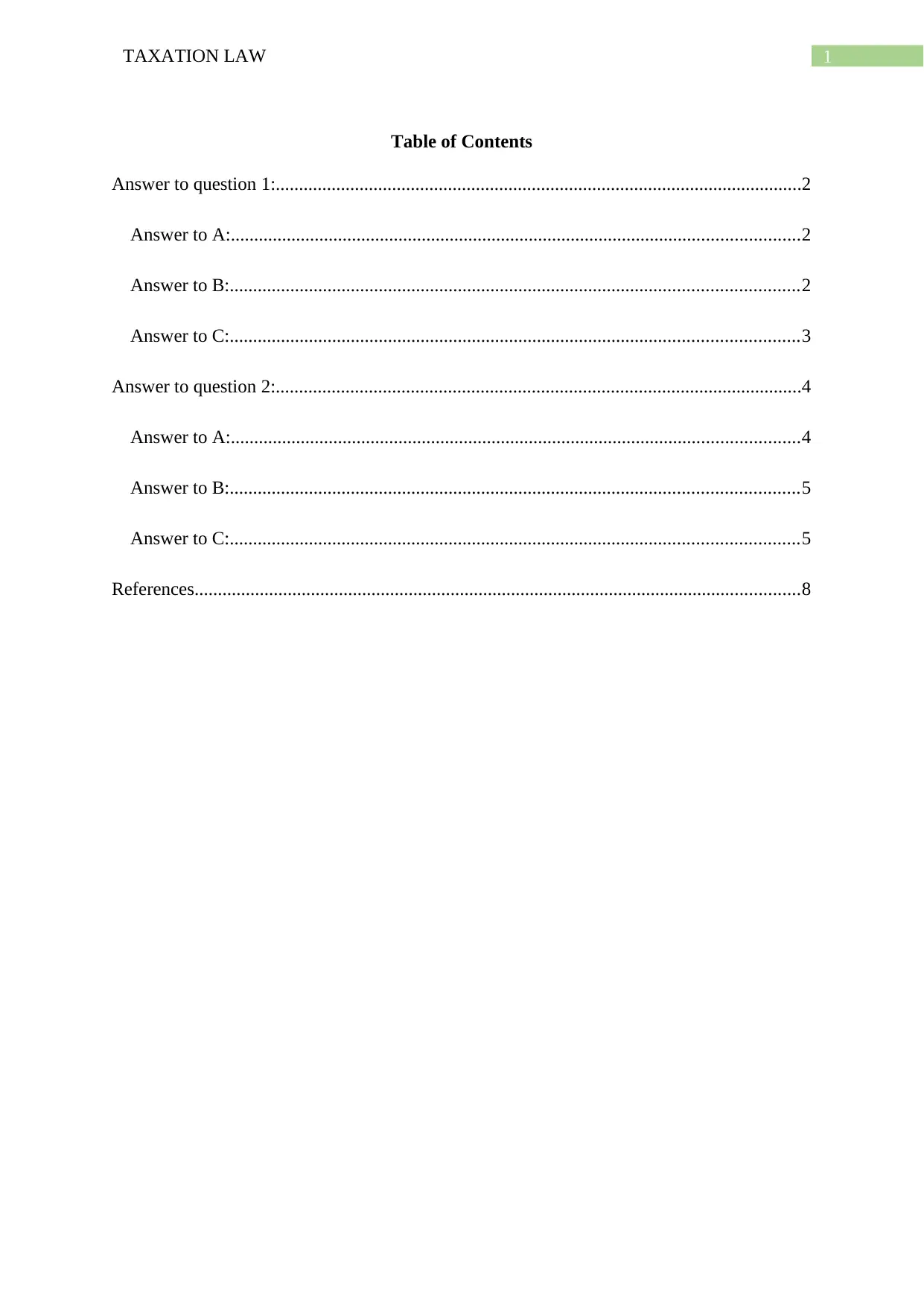
1TAXATION LAW
Table of Contents
Answer to question 1:.................................................................................................................2
Answer to A:..........................................................................................................................2
Answer to B:..........................................................................................................................2
Answer to C:..........................................................................................................................3
Answer to question 2:.................................................................................................................4
Answer to A:..........................................................................................................................4
Answer to B:..........................................................................................................................5
Answer to C:..........................................................................................................................5
References..................................................................................................................................8
Table of Contents
Answer to question 1:.................................................................................................................2
Answer to A:..........................................................................................................................2
Answer to B:..........................................................................................................................2
Answer to C:..........................................................................................................................3
Answer to question 2:.................................................................................................................4
Answer to A:..........................................................................................................................4
Answer to B:..........................................................................................................................5
Answer to C:..........................................................................................................................5
References..................................................................................................................................8
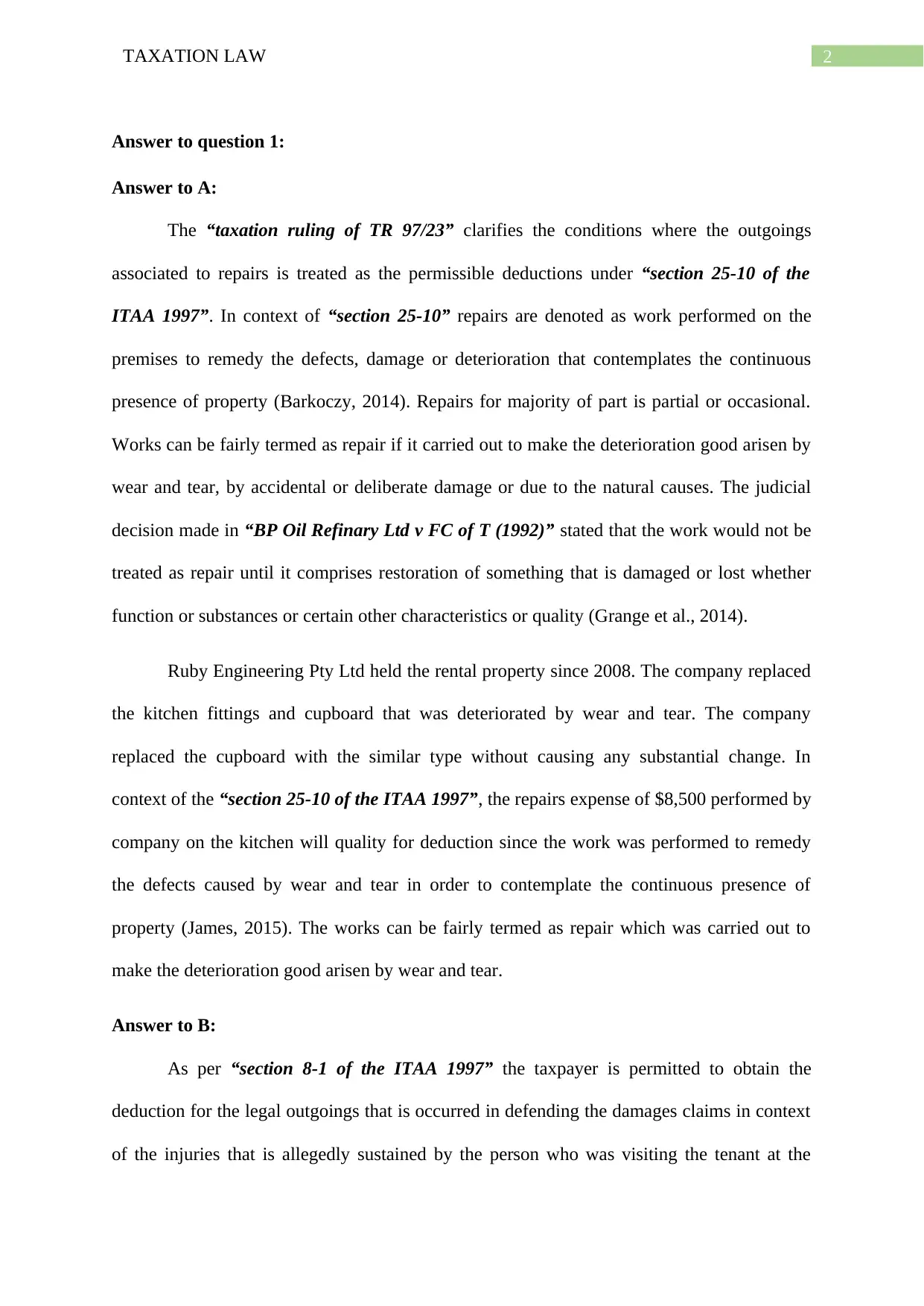
2TAXATION LAW
Answer to question 1:
Answer to A:
The “taxation ruling of TR 97/23” clarifies the conditions where the outgoings
associated to repairs is treated as the permissible deductions under “section 25-10 of the
ITAA 1997”. In context of “section 25-10” repairs are denoted as work performed on the
premises to remedy the defects, damage or deterioration that contemplates the continuous
presence of property (Barkoczy, 2014). Repairs for majority of part is partial or occasional.
Works can be fairly termed as repair if it carried out to make the deterioration good arisen by
wear and tear, by accidental or deliberate damage or due to the natural causes. The judicial
decision made in “BP Oil Refinary Ltd v FC of T (1992)” stated that the work would not be
treated as repair until it comprises restoration of something that is damaged or lost whether
function or substances or certain other characteristics or quality (Grange et al., 2014).
Ruby Engineering Pty Ltd held the rental property since 2008. The company replaced
the kitchen fittings and cupboard that was deteriorated by wear and tear. The company
replaced the cupboard with the similar type without causing any substantial change. In
context of the “section 25-10 of the ITAA 1997”, the repairs expense of $8,500 performed by
company on the kitchen will quality for deduction since the work was performed to remedy
the defects caused by wear and tear in order to contemplate the continuous presence of
property (James, 2015). The works can be fairly termed as repair which was carried out to
make the deterioration good arisen by wear and tear.
Answer to B:
As per “section 8-1 of the ITAA 1997” the taxpayer is permitted to obtain the
deduction for the legal outgoings that is occurred in defending the damages claims in context
of the injuries that is allegedly sustained by the person who was visiting the tenant at the
Answer to question 1:
Answer to A:
The “taxation ruling of TR 97/23” clarifies the conditions where the outgoings
associated to repairs is treated as the permissible deductions under “section 25-10 of the
ITAA 1997”. In context of “section 25-10” repairs are denoted as work performed on the
premises to remedy the defects, damage or deterioration that contemplates the continuous
presence of property (Barkoczy, 2014). Repairs for majority of part is partial or occasional.
Works can be fairly termed as repair if it carried out to make the deterioration good arisen by
wear and tear, by accidental or deliberate damage or due to the natural causes. The judicial
decision made in “BP Oil Refinary Ltd v FC of T (1992)” stated that the work would not be
treated as repair until it comprises restoration of something that is damaged or lost whether
function or substances or certain other characteristics or quality (Grange et al., 2014).
Ruby Engineering Pty Ltd held the rental property since 2008. The company replaced
the kitchen fittings and cupboard that was deteriorated by wear and tear. The company
replaced the cupboard with the similar type without causing any substantial change. In
context of the “section 25-10 of the ITAA 1997”, the repairs expense of $8,500 performed by
company on the kitchen will quality for deduction since the work was performed to remedy
the defects caused by wear and tear in order to contemplate the continuous presence of
property (James, 2015). The works can be fairly termed as repair which was carried out to
make the deterioration good arisen by wear and tear.
Answer to B:
As per “section 8-1 of the ITAA 1997” the taxpayer is permitted to obtain the
deduction for the legal outgoings that is occurred in defending the damages claims in context
of the injuries that is allegedly sustained by the person who was visiting the tenant at the
⊘ This is a preview!⊘
Do you want full access?
Subscribe today to unlock all pages.

Trusted by 1+ million students worldwide
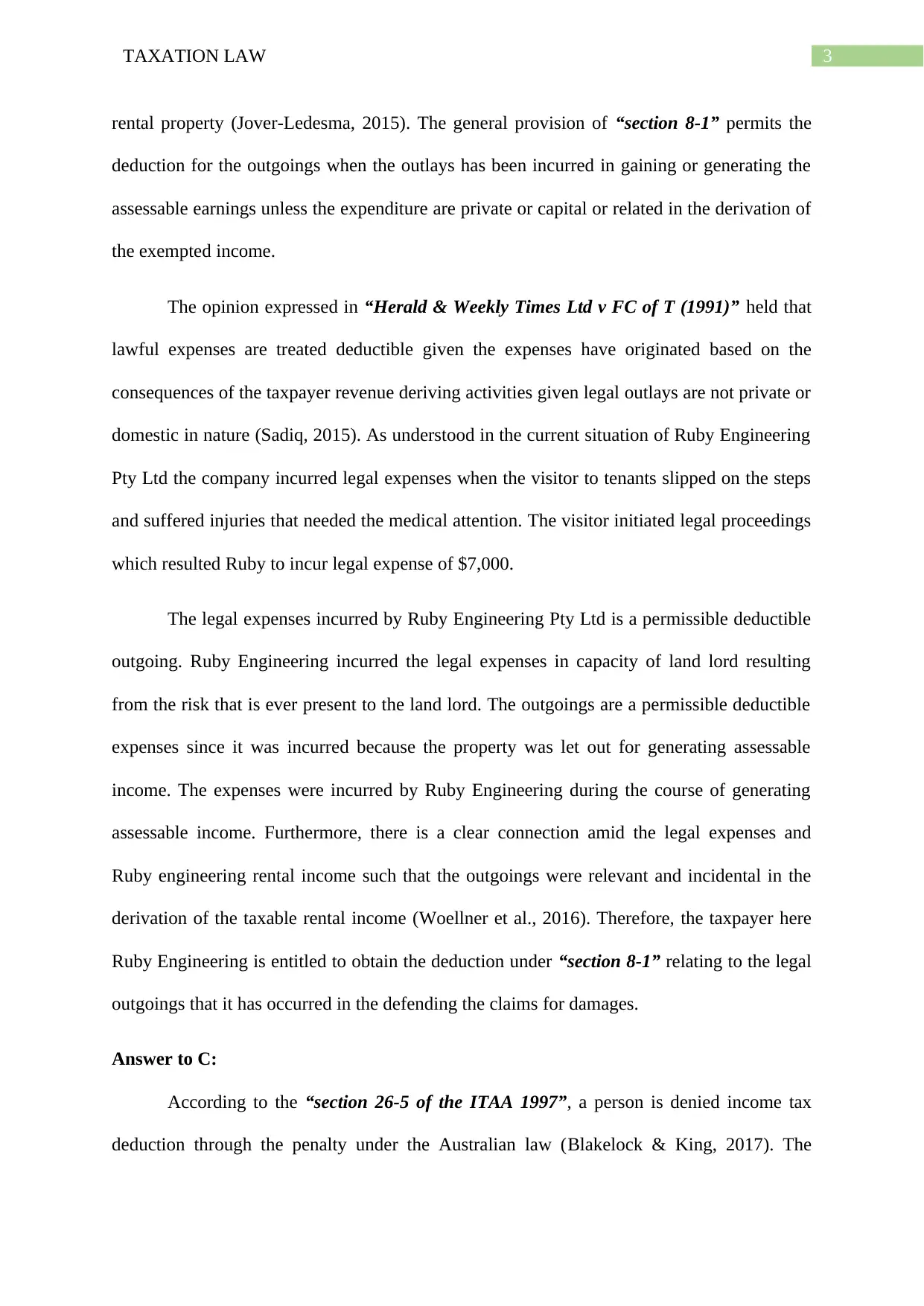
3TAXATION LAW
rental property (Jover-Ledesma, 2015). The general provision of “section 8-1” permits the
deduction for the outgoings when the outlays has been incurred in gaining or generating the
assessable earnings unless the expenditure are private or capital or related in the derivation of
the exempted income.
The opinion expressed in “Herald & Weekly Times Ltd v FC of T (1991)” held that
lawful expenses are treated deductible given the expenses have originated based on the
consequences of the taxpayer revenue deriving activities given legal outlays are not private or
domestic in nature (Sadiq, 2015). As understood in the current situation of Ruby Engineering
Pty Ltd the company incurred legal expenses when the visitor to tenants slipped on the steps
and suffered injuries that needed the medical attention. The visitor initiated legal proceedings
which resulted Ruby to incur legal expense of $7,000.
The legal expenses incurred by Ruby Engineering Pty Ltd is a permissible deductible
outgoing. Ruby Engineering incurred the legal expenses in capacity of land lord resulting
from the risk that is ever present to the land lord. The outgoings are a permissible deductible
expenses since it was incurred because the property was let out for generating assessable
income. The expenses were incurred by Ruby Engineering during the course of generating
assessable income. Furthermore, there is a clear connection amid the legal expenses and
Ruby engineering rental income such that the outgoings were relevant and incidental in the
derivation of the taxable rental income (Woellner et al., 2016). Therefore, the taxpayer here
Ruby Engineering is entitled to obtain the deduction under “section 8-1” relating to the legal
outgoings that it has occurred in the defending the claims for damages.
Answer to C:
According to the “section 26-5 of the ITAA 1997”, a person is denied income tax
deduction through the penalty under the Australian law (Blakelock & King, 2017). The
rental property (Jover-Ledesma, 2015). The general provision of “section 8-1” permits the
deduction for the outgoings when the outlays has been incurred in gaining or generating the
assessable earnings unless the expenditure are private or capital or related in the derivation of
the exempted income.
The opinion expressed in “Herald & Weekly Times Ltd v FC of T (1991)” held that
lawful expenses are treated deductible given the expenses have originated based on the
consequences of the taxpayer revenue deriving activities given legal outlays are not private or
domestic in nature (Sadiq, 2015). As understood in the current situation of Ruby Engineering
Pty Ltd the company incurred legal expenses when the visitor to tenants slipped on the steps
and suffered injuries that needed the medical attention. The visitor initiated legal proceedings
which resulted Ruby to incur legal expense of $7,000.
The legal expenses incurred by Ruby Engineering Pty Ltd is a permissible deductible
outgoing. Ruby Engineering incurred the legal expenses in capacity of land lord resulting
from the risk that is ever present to the land lord. The outgoings are a permissible deductible
expenses since it was incurred because the property was let out for generating assessable
income. The expenses were incurred by Ruby Engineering during the course of generating
assessable income. Furthermore, there is a clear connection amid the legal expenses and
Ruby engineering rental income such that the outgoings were relevant and incidental in the
derivation of the taxable rental income (Woellner et al., 2016). Therefore, the taxpayer here
Ruby Engineering is entitled to obtain the deduction under “section 8-1” relating to the legal
outgoings that it has occurred in the defending the claims for damages.
Answer to C:
According to the “section 26-5 of the ITAA 1997”, a person is denied income tax
deduction through the penalty under the Australian law (Blakelock & King, 2017). The
Paraphrase This Document
Need a fresh take? Get an instant paraphrase of this document with our AI Paraphraser
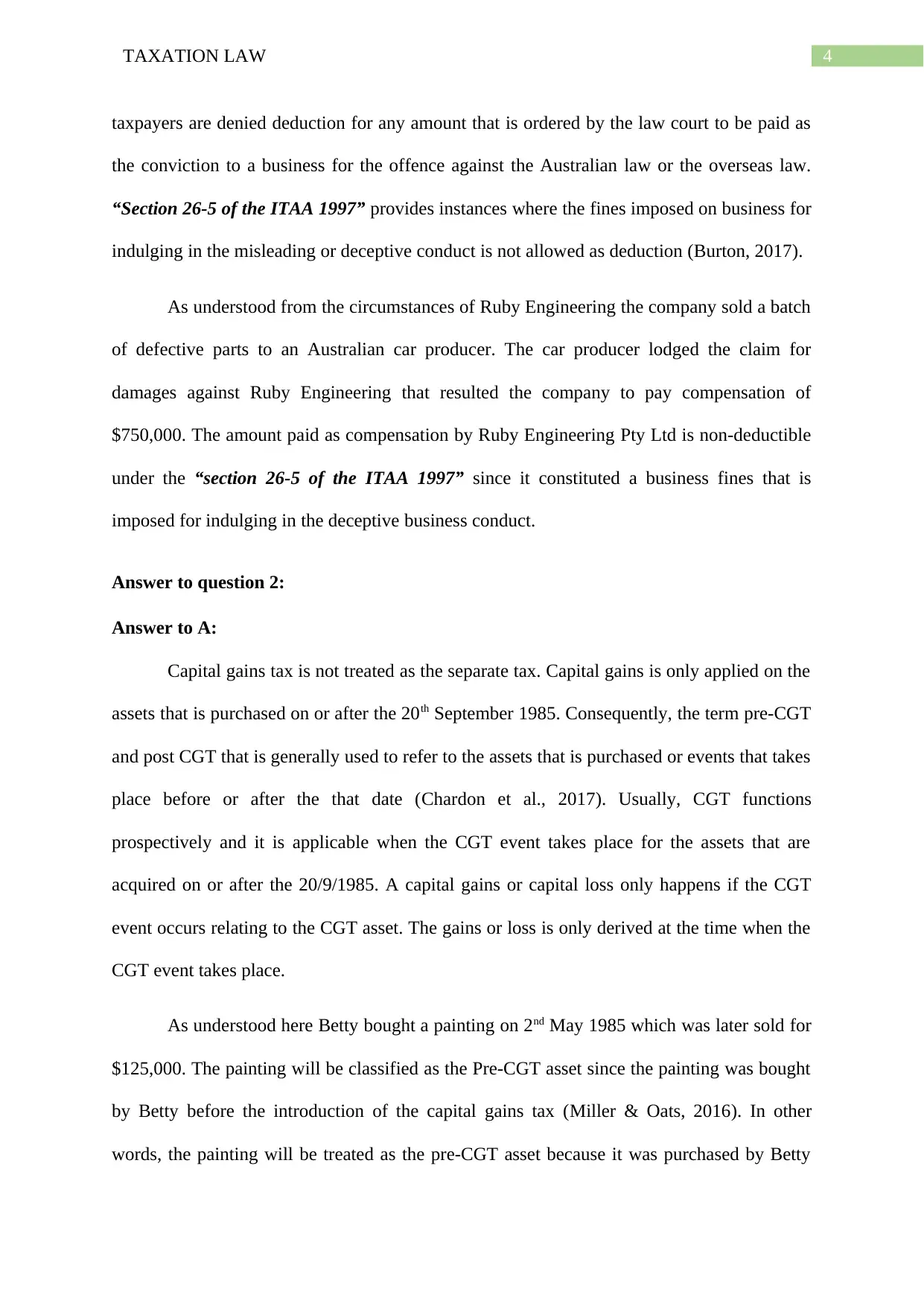
4TAXATION LAW
taxpayers are denied deduction for any amount that is ordered by the law court to be paid as
the conviction to a business for the offence against the Australian law or the overseas law.
“Section 26-5 of the ITAA 1997” provides instances where the fines imposed on business for
indulging in the misleading or deceptive conduct is not allowed as deduction (Burton, 2017).
As understood from the circumstances of Ruby Engineering the company sold a batch
of defective parts to an Australian car producer. The car producer lodged the claim for
damages against Ruby Engineering that resulted the company to pay compensation of
$750,000. The amount paid as compensation by Ruby Engineering Pty Ltd is non-deductible
under the “section 26-5 of the ITAA 1997” since it constituted a business fines that is
imposed for indulging in the deceptive business conduct.
Answer to question 2:
Answer to A:
Capital gains tax is not treated as the separate tax. Capital gains is only applied on the
assets that is purchased on or after the 20th September 1985. Consequently, the term pre-CGT
and post CGT that is generally used to refer to the assets that is purchased or events that takes
place before or after the that date (Chardon et al., 2017). Usually, CGT functions
prospectively and it is applicable when the CGT event takes place for the assets that are
acquired on or after the 20/9/1985. A capital gains or capital loss only happens if the CGT
event occurs relating to the CGT asset. The gains or loss is only derived at the time when the
CGT event takes place.
As understood here Betty bought a painting on 2nd May 1985 which was later sold for
$125,000. The painting will be classified as the Pre-CGT asset since the painting was bought
by Betty before the introduction of the capital gains tax (Miller & Oats, 2016). In other
words, the painting will be treated as the pre-CGT asset because it was purchased by Betty
taxpayers are denied deduction for any amount that is ordered by the law court to be paid as
the conviction to a business for the offence against the Australian law or the overseas law.
“Section 26-5 of the ITAA 1997” provides instances where the fines imposed on business for
indulging in the misleading or deceptive conduct is not allowed as deduction (Burton, 2017).
As understood from the circumstances of Ruby Engineering the company sold a batch
of defective parts to an Australian car producer. The car producer lodged the claim for
damages against Ruby Engineering that resulted the company to pay compensation of
$750,000. The amount paid as compensation by Ruby Engineering Pty Ltd is non-deductible
under the “section 26-5 of the ITAA 1997” since it constituted a business fines that is
imposed for indulging in the deceptive business conduct.
Answer to question 2:
Answer to A:
Capital gains tax is not treated as the separate tax. Capital gains is only applied on the
assets that is purchased on or after the 20th September 1985. Consequently, the term pre-CGT
and post CGT that is generally used to refer to the assets that is purchased or events that takes
place before or after the that date (Chardon et al., 2017). Usually, CGT functions
prospectively and it is applicable when the CGT event takes place for the assets that are
acquired on or after the 20/9/1985. A capital gains or capital loss only happens if the CGT
event occurs relating to the CGT asset. The gains or loss is only derived at the time when the
CGT event takes place.
As understood here Betty bought a painting on 2nd May 1985 which was later sold for
$125,000. The painting will be classified as the Pre-CGT asset since the painting was bought
by Betty before the introduction of the capital gains tax (Miller & Oats, 2016). In other
words, the painting will be treated as the pre-CGT asset because it was purchased by Betty
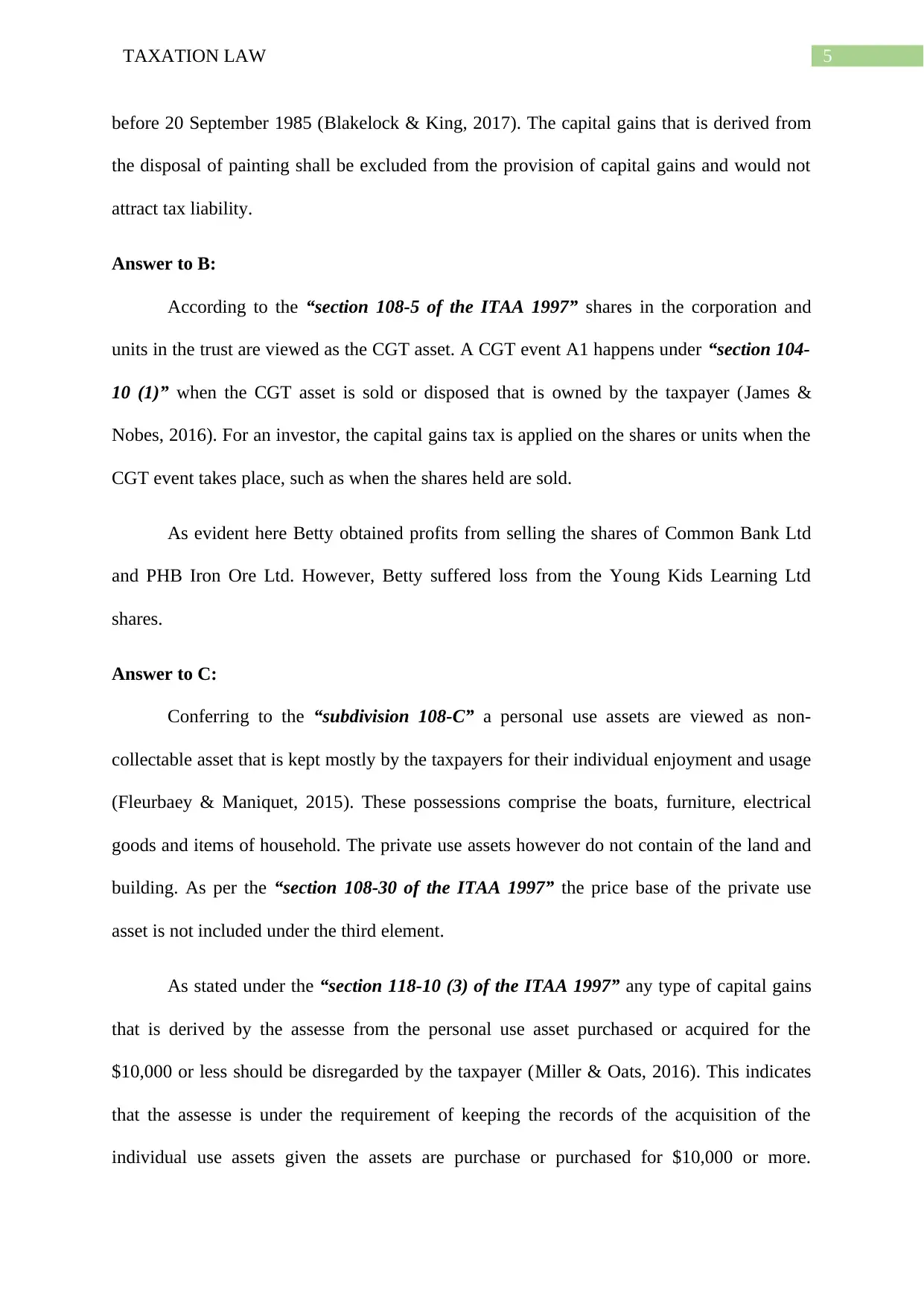
5TAXATION LAW
before 20 September 1985 (Blakelock & King, 2017). The capital gains that is derived from
the disposal of painting shall be excluded from the provision of capital gains and would not
attract tax liability.
Answer to B:
According to the “section 108-5 of the ITAA 1997” shares in the corporation and
units in the trust are viewed as the CGT asset. A CGT event A1 happens under “section 104-
10 (1)” when the CGT asset is sold or disposed that is owned by the taxpayer (James &
Nobes, 2016). For an investor, the capital gains tax is applied on the shares or units when the
CGT event takes place, such as when the shares held are sold.
As evident here Betty obtained profits from selling the shares of Common Bank Ltd
and PHB Iron Ore Ltd. However, Betty suffered loss from the Young Kids Learning Ltd
shares.
Answer to C:
Conferring to the “subdivision 108-C” a personal use assets are viewed as non-
collectable asset that is kept mostly by the taxpayers for their individual enjoyment and usage
(Fleurbaey & Maniquet, 2015). These possessions comprise the boats, furniture, electrical
goods and items of household. The private use assets however do not contain of the land and
building. As per the “section 108-30 of the ITAA 1997” the price base of the private use
asset is not included under the third element.
As stated under the “section 118-10 (3) of the ITAA 1997” any type of capital gains
that is derived by the assesse from the personal use asset purchased or acquired for the
$10,000 or less should be disregarded by the taxpayer (Miller & Oats, 2016). This indicates
that the assesse is under the requirement of keeping the records of the acquisition of the
individual use assets given the assets are purchase or purchased for $10,000 or more.
before 20 September 1985 (Blakelock & King, 2017). The capital gains that is derived from
the disposal of painting shall be excluded from the provision of capital gains and would not
attract tax liability.
Answer to B:
According to the “section 108-5 of the ITAA 1997” shares in the corporation and
units in the trust are viewed as the CGT asset. A CGT event A1 happens under “section 104-
10 (1)” when the CGT asset is sold or disposed that is owned by the taxpayer (James &
Nobes, 2016). For an investor, the capital gains tax is applied on the shares or units when the
CGT event takes place, such as when the shares held are sold.
As evident here Betty obtained profits from selling the shares of Common Bank Ltd
and PHB Iron Ore Ltd. However, Betty suffered loss from the Young Kids Learning Ltd
shares.
Answer to C:
Conferring to the “subdivision 108-C” a personal use assets are viewed as non-
collectable asset that is kept mostly by the taxpayers for their individual enjoyment and usage
(Fleurbaey & Maniquet, 2015). These possessions comprise the boats, furniture, electrical
goods and items of household. The private use assets however do not contain of the land and
building. As per the “section 108-30 of the ITAA 1997” the price base of the private use
asset is not included under the third element.
As stated under the “section 118-10 (3) of the ITAA 1997” any type of capital gains
that is derived by the assesse from the personal use asset purchased or acquired for the
$10,000 or less should be disregarded by the taxpayer (Miller & Oats, 2016). This indicates
that the assesse is under the requirement of keeping the records of the acquisition of the
individual use assets given the assets are purchase or purchased for $10,000 or more.
⊘ This is a preview!⊘
Do you want full access?
Subscribe today to unlock all pages.

Trusted by 1+ million students worldwide
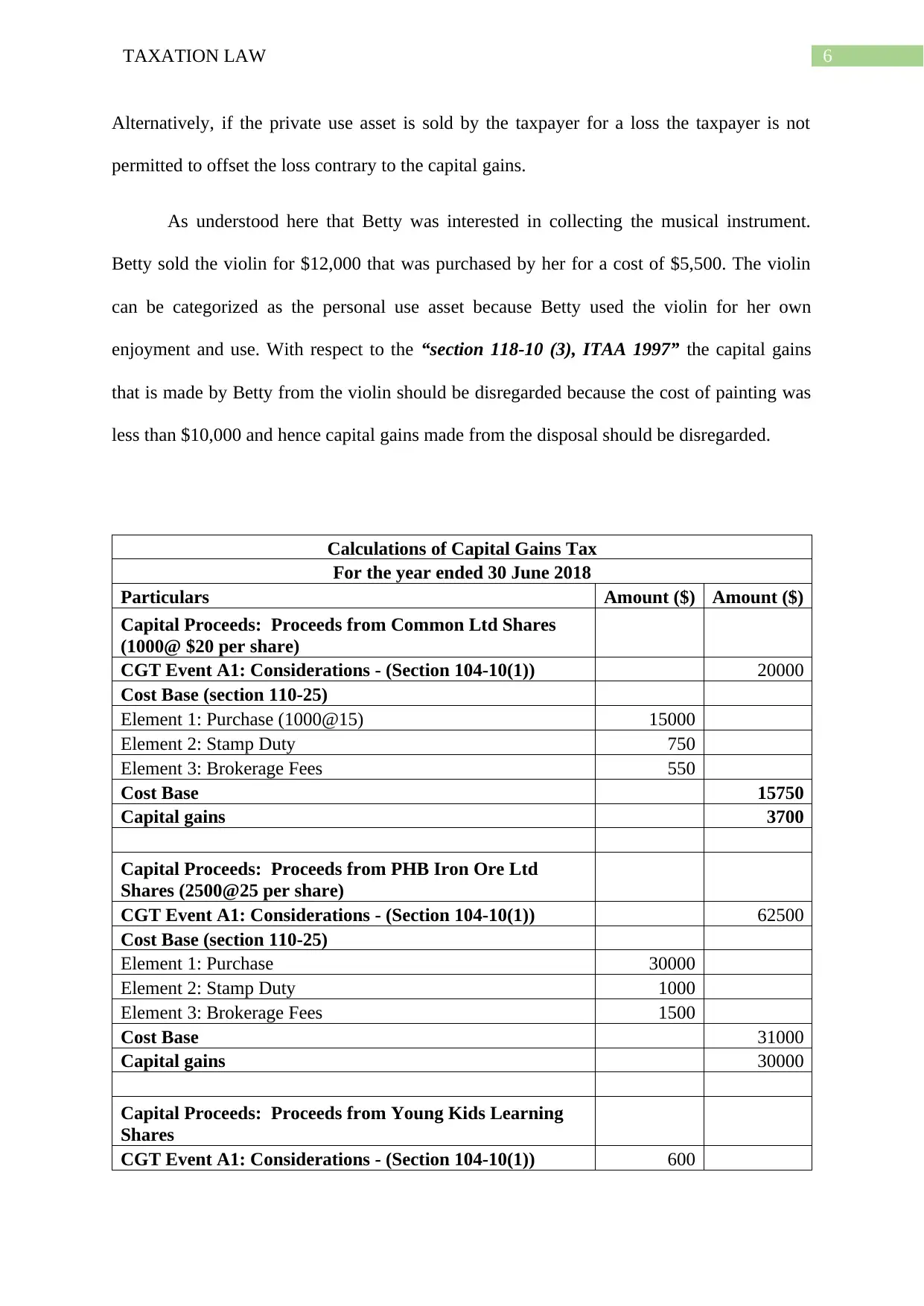
6TAXATION LAW
Alternatively, if the private use asset is sold by the taxpayer for a loss the taxpayer is not
permitted to offset the loss contrary to the capital gains.
As understood here that Betty was interested in collecting the musical instrument.
Betty sold the violin for $12,000 that was purchased by her for a cost of $5,500. The violin
can be categorized as the personal use asset because Betty used the violin for her own
enjoyment and use. With respect to the “section 118-10 (3), ITAA 1997” the capital gains
that is made by Betty from the violin should be disregarded because the cost of painting was
less than $10,000 and hence capital gains made from the disposal should be disregarded.
Calculations of Capital Gains Tax
For the year ended 30 June 2018
Particulars Amount ($) Amount ($)
Capital Proceeds: Proceeds from Common Ltd Shares
(1000@ $20 per share)
CGT Event A1: Considerations - (Section 104-10(1)) 20000
Cost Base (section 110-25)
Element 1: Purchase (1000@15) 15000
Element 2: Stamp Duty 750
Element 3: Brokerage Fees 550
Cost Base 15750
Capital gains 3700
Capital Proceeds: Proceeds from PHB Iron Ore Ltd
Shares (2500@25 per share)
CGT Event A1: Considerations - (Section 104-10(1)) 62500
Cost Base (section 110-25)
Element 1: Purchase 30000
Element 2: Stamp Duty 1000
Element 3: Brokerage Fees 1500
Cost Base 31000
Capital gains 30000
Capital Proceeds: Proceeds from Young Kids Learning
Shares
CGT Event A1: Considerations - (Section 104-10(1)) 600
Alternatively, if the private use asset is sold by the taxpayer for a loss the taxpayer is not
permitted to offset the loss contrary to the capital gains.
As understood here that Betty was interested in collecting the musical instrument.
Betty sold the violin for $12,000 that was purchased by her for a cost of $5,500. The violin
can be categorized as the personal use asset because Betty used the violin for her own
enjoyment and use. With respect to the “section 118-10 (3), ITAA 1997” the capital gains
that is made by Betty from the violin should be disregarded because the cost of painting was
less than $10,000 and hence capital gains made from the disposal should be disregarded.
Calculations of Capital Gains Tax
For the year ended 30 June 2018
Particulars Amount ($) Amount ($)
Capital Proceeds: Proceeds from Common Ltd Shares
(1000@ $20 per share)
CGT Event A1: Considerations - (Section 104-10(1)) 20000
Cost Base (section 110-25)
Element 1: Purchase (1000@15) 15000
Element 2: Stamp Duty 750
Element 3: Brokerage Fees 550
Cost Base 15750
Capital gains 3700
Capital Proceeds: Proceeds from PHB Iron Ore Ltd
Shares (2500@25 per share)
CGT Event A1: Considerations - (Section 104-10(1)) 62500
Cost Base (section 110-25)
Element 1: Purchase 30000
Element 2: Stamp Duty 1000
Element 3: Brokerage Fees 1500
Cost Base 31000
Capital gains 30000
Capital Proceeds: Proceeds from Young Kids Learning
Shares
CGT Event A1: Considerations - (Section 104-10(1)) 600
Paraphrase This Document
Need a fresh take? Get an instant paraphrase of this document with our AI Paraphraser
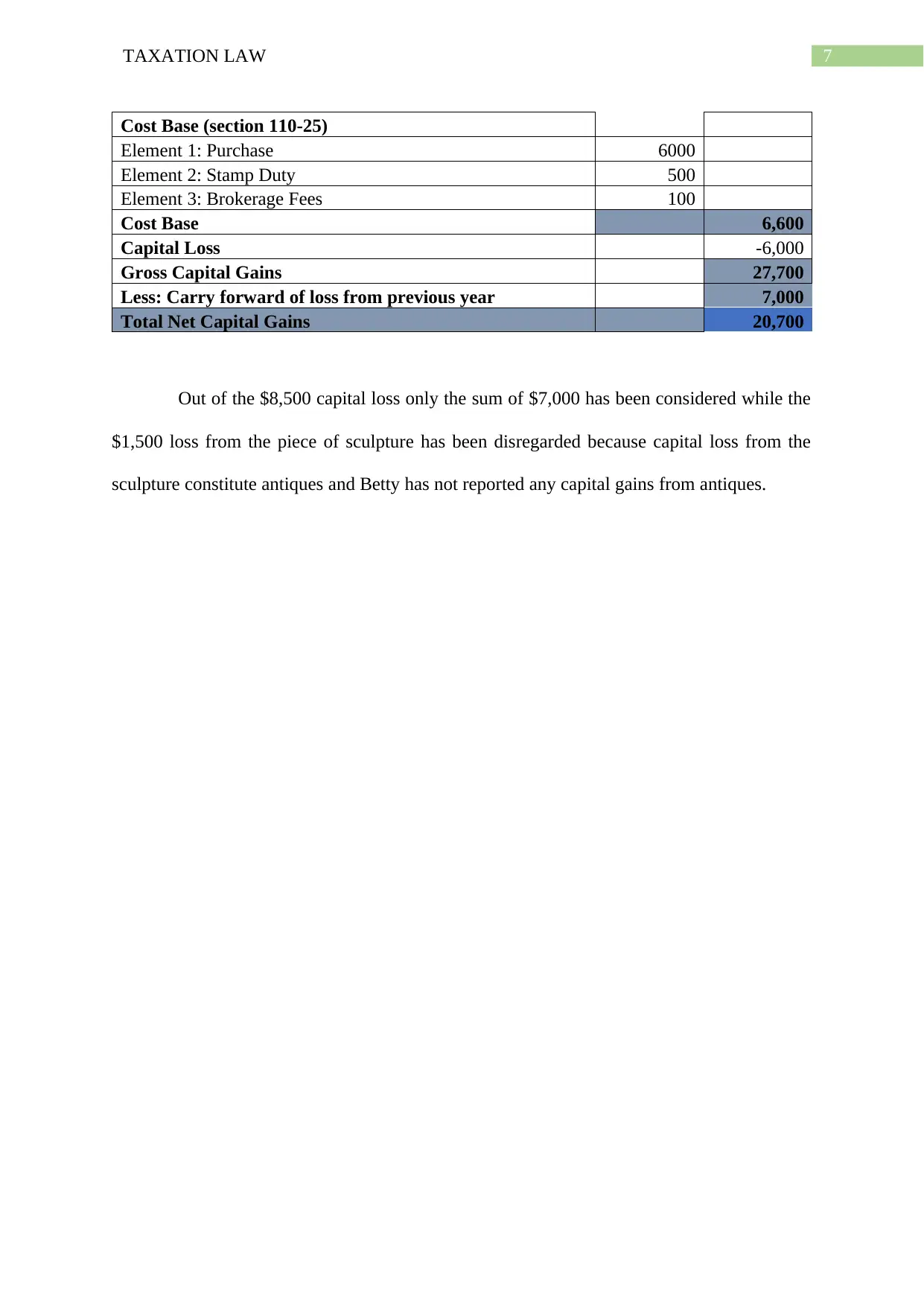
7TAXATION LAW
Cost Base (section 110-25)
Element 1: Purchase 6000
Element 2: Stamp Duty 500
Element 3: Brokerage Fees 100
Cost Base 6,600
Capital Loss -6,000
Gross Capital Gains 27,700
Less: Carry forward of loss from previous year 7,000
Total Net Capital Gains 20,700
Out of the $8,500 capital loss only the sum of $7,000 has been considered while the
$1,500 loss from the piece of sculpture has been disregarded because capital loss from the
sculpture constitute antiques and Betty has not reported any capital gains from antiques.
Cost Base (section 110-25)
Element 1: Purchase 6000
Element 2: Stamp Duty 500
Element 3: Brokerage Fees 100
Cost Base 6,600
Capital Loss -6,000
Gross Capital Gains 27,700
Less: Carry forward of loss from previous year 7,000
Total Net Capital Gains 20,700
Out of the $8,500 capital loss only the sum of $7,000 has been considered while the
$1,500 loss from the piece of sculpture has been disregarded because capital loss from the
sculpture constitute antiques and Betty has not reported any capital gains from antiques.
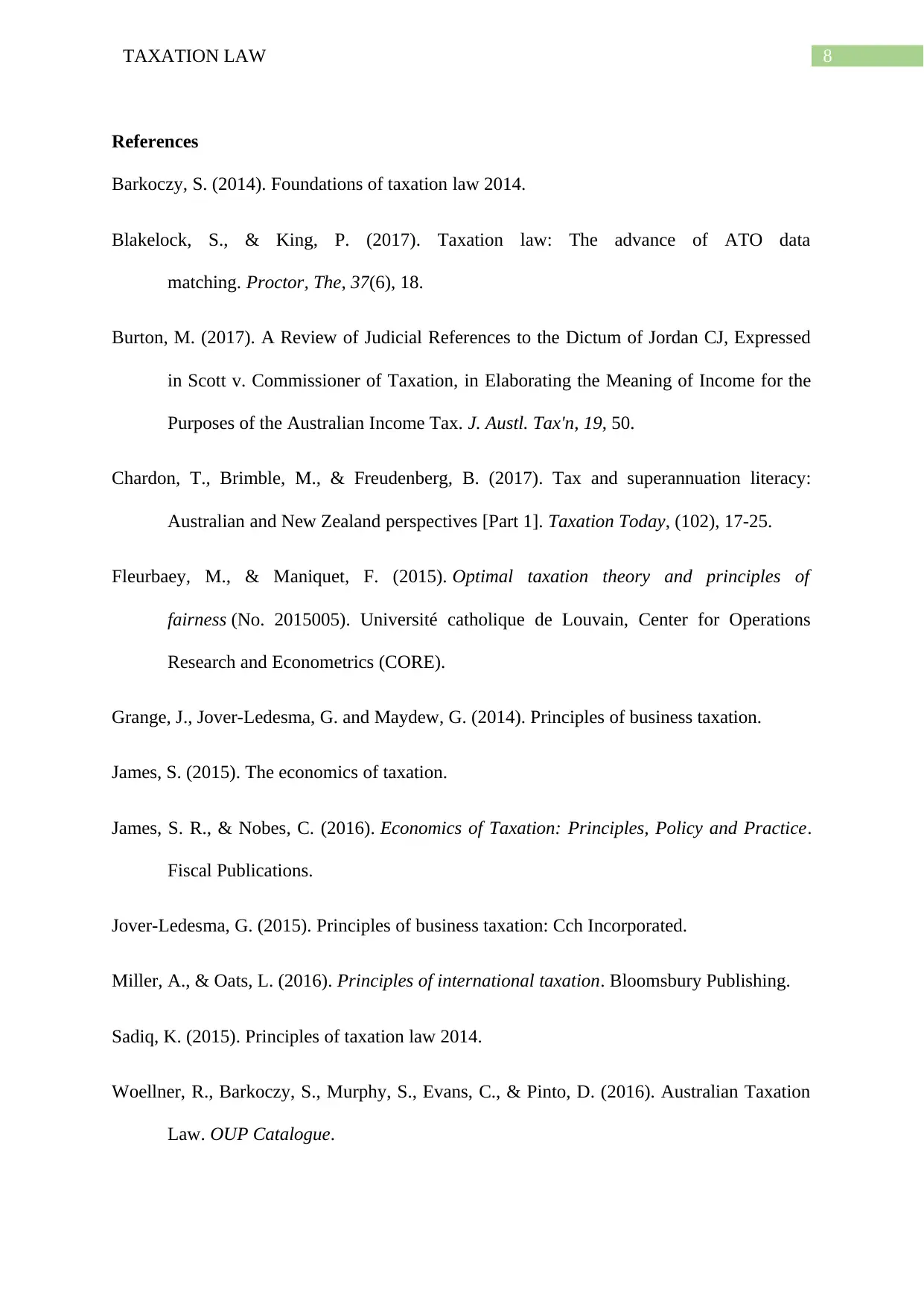
8TAXATION LAW
References
Barkoczy, S. (2014). Foundations of taxation law 2014.
Blakelock, S., & King, P. (2017). Taxation law: The advance of ATO data
matching. Proctor, The, 37(6), 18.
Burton, M. (2017). A Review of Judicial References to the Dictum of Jordan CJ, Expressed
in Scott v. Commissioner of Taxation, in Elaborating the Meaning of Income for the
Purposes of the Australian Income Tax. J. Austl. Tax'n, 19, 50.
Chardon, T., Brimble, M., & Freudenberg, B. (2017). Tax and superannuation literacy:
Australian and New Zealand perspectives [Part 1]. Taxation Today, (102), 17-25.
Fleurbaey, M., & Maniquet, F. (2015). Optimal taxation theory and principles of
fairness (No. 2015005). Université catholique de Louvain, Center for Operations
Research and Econometrics (CORE).
Grange, J., Jover-Ledesma, G. and Maydew, G. (2014). Principles of business taxation.
James, S. (2015). The economics of taxation.
James, S. R., & Nobes, C. (2016). Economics of Taxation: Principles, Policy and Practice.
Fiscal Publications.
Jover-Ledesma, G. (2015). Principles of business taxation: Cch Incorporated.
Miller, A., & Oats, L. (2016). Principles of international taxation. Bloomsbury Publishing.
Sadiq, K. (2015). Principles of taxation law 2014.
Woellner, R., Barkoczy, S., Murphy, S., Evans, C., & Pinto, D. (2016). Australian Taxation
Law. OUP Catalogue.
References
Barkoczy, S. (2014). Foundations of taxation law 2014.
Blakelock, S., & King, P. (2017). Taxation law: The advance of ATO data
matching. Proctor, The, 37(6), 18.
Burton, M. (2017). A Review of Judicial References to the Dictum of Jordan CJ, Expressed
in Scott v. Commissioner of Taxation, in Elaborating the Meaning of Income for the
Purposes of the Australian Income Tax. J. Austl. Tax'n, 19, 50.
Chardon, T., Brimble, M., & Freudenberg, B. (2017). Tax and superannuation literacy:
Australian and New Zealand perspectives [Part 1]. Taxation Today, (102), 17-25.
Fleurbaey, M., & Maniquet, F. (2015). Optimal taxation theory and principles of
fairness (No. 2015005). Université catholique de Louvain, Center for Operations
Research and Econometrics (CORE).
Grange, J., Jover-Ledesma, G. and Maydew, G. (2014). Principles of business taxation.
James, S. (2015). The economics of taxation.
James, S. R., & Nobes, C. (2016). Economics of Taxation: Principles, Policy and Practice.
Fiscal Publications.
Jover-Ledesma, G. (2015). Principles of business taxation: Cch Incorporated.
Miller, A., & Oats, L. (2016). Principles of international taxation. Bloomsbury Publishing.
Sadiq, K. (2015). Principles of taxation law 2014.
Woellner, R., Barkoczy, S., Murphy, S., Evans, C., & Pinto, D. (2016). Australian Taxation
Law. OUP Catalogue.
⊘ This is a preview!⊘
Do you want full access?
Subscribe today to unlock all pages.

Trusted by 1+ million students worldwide
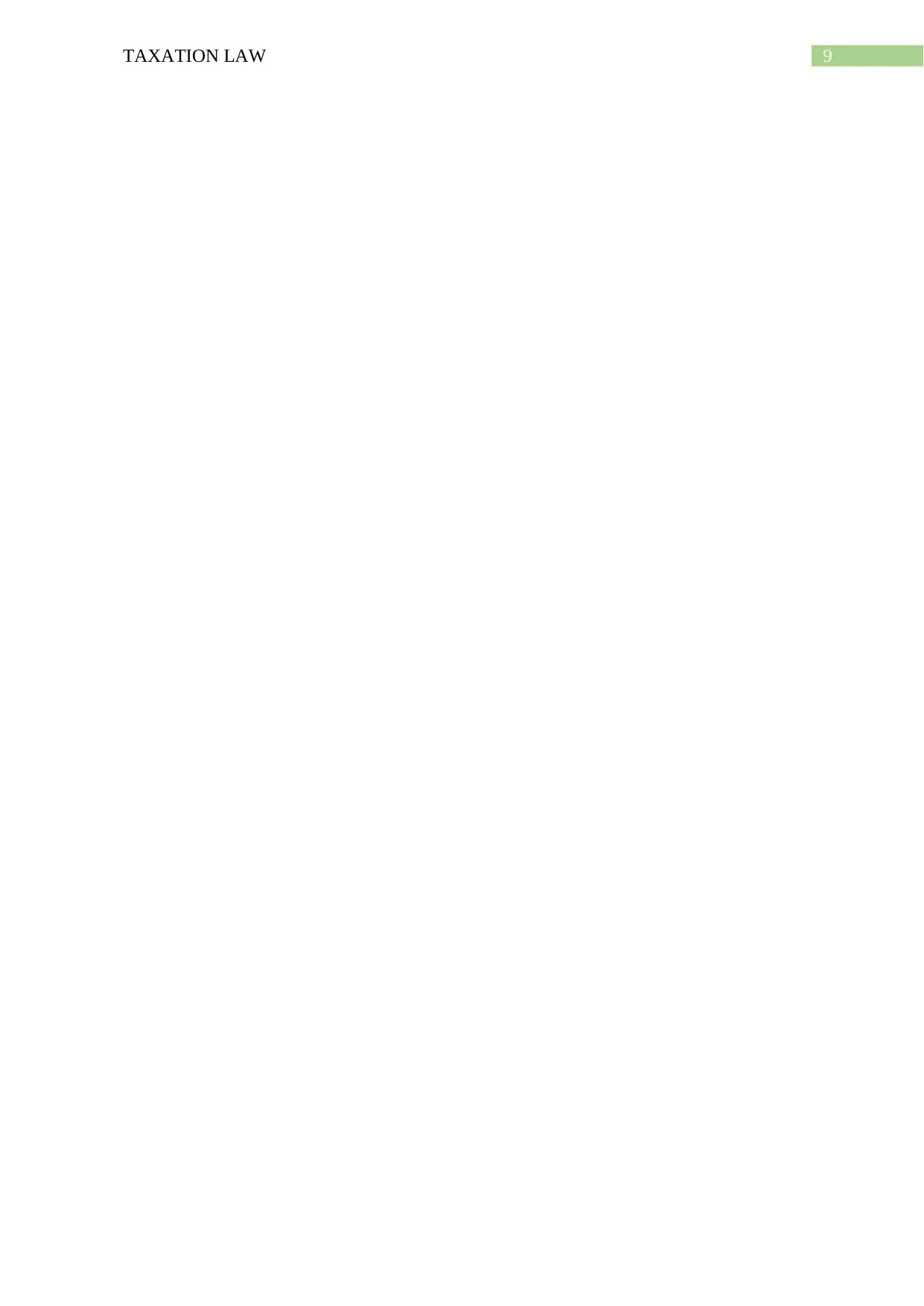
9TAXATION LAW
1 out of 10
Related Documents
Your All-in-One AI-Powered Toolkit for Academic Success.
+13062052269
info@desklib.com
Available 24*7 on WhatsApp / Email
![[object Object]](/_next/static/media/star-bottom.7253800d.svg)
Unlock your academic potential
Copyright © 2020–2025 A2Z Services. All Rights Reserved. Developed and managed by ZUCOL.





